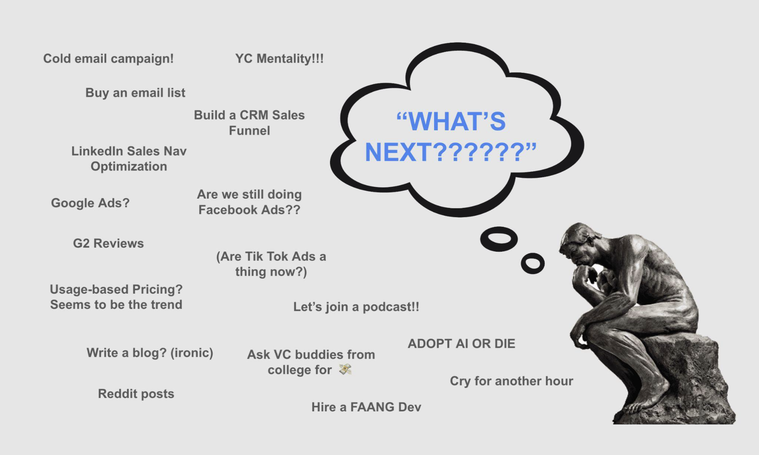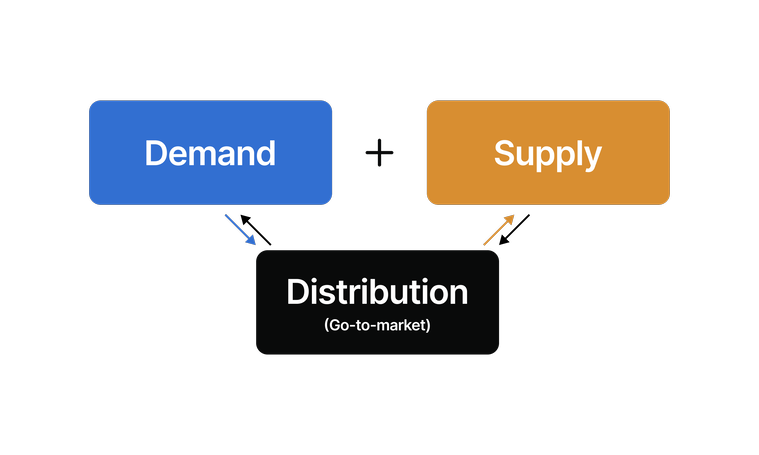How You Can Succeed in the Pre-PMF Path as a Founder
What is product-market fit?
Whenever the phrase “product-market fit (PMF)” arises, I often pose the question, “How do you define PMF?”
Opinions vary. Some suggest the best indicator is the net promoter score (NPS), while others associate it with retention or organic growth metrics. Rather than assigning a variable to PMF, I like to define it as a period where “you have back-to-back onboarding meetings for 10 hours a day for 10 consecutive days.”
This intense period typically corresponds with achieving an annual recurring revenue (ARR) of around $100k - $200k. So what happens before this period? How does one attain product-market fit? Which frameworks work the most efficiently and which ones should you avoid?
If you’re a ‘framework’ founder who’s obsessed with structured approaches, which I believe most of the founders are and should be. You likely read The Lean Startup by Eric Ries and Zero to One by Peter Thiel and embraced their value props. Perhaps conducted customer discovery, adopted agile methodologies you’ve learned from your previous tech job, determined a north star, monitored key performance indicators (KPIs), and followed other guidelines that the so-called “entrepreneurs” sell online. These are all valuable practices; sadly, they tend to work much better once you find product market fit. Earn the right to think long-term.
“Why is this so f** hard?… It seems as if all these idiots are succeeding without even solving a real issue”—many founder friends to themselves in the mirror every day (including myself).
Frameworks: Your worst Pre-PMF friend
As a founder, your response to “list of things I have to do?” is probably like the following:

Hate to break it to you, but ‘framework’ founders often get overwhelmed & fail because there is no good framework to transition from zero to one.
From my research and conversations with seasonal entrepreneurs, the biggest advice I discovered is to engage with potential customers before writing a single line of code.
Your initial groundwork should only involve talking with over 100 potential customers and asking the simple question: "What can I build for you, realistically, that you’ll jump on to buy?” Don’t bother with not having “past experience” in your relative field; if you’re technical, go learn it—it’s mostly just a different application of your fundamental knowledge. If you’re not technical, well, go find yourself a technical co-founder and make sure you’re extraordinary when it comes to the operational side.
PMF hinges on three key components: Demand, Supply, and Distribution. Among these, finding demand is the hardest part because it’s beyond your control; there is nothing you can do to change it—a tough pill to swallow.
Your focus should be on finding one pocket of intense demand and one type of customer. Once you identify these, product development will naturally follow. In a future post, I plan to delve deeper into each of these three aspects of PMF.
Demand: Most important yet least understood
I often like to explain demand as falling in love with someone. How does one approach it? Do you talk with them about your interests? Obviously not… at least, it didn’t seem to be the case in my experience.
You go next to them, understand what they are looking for in a relationship, what their priorities are, how they evaluate their options, and if there is a place for you in this story. Many times, they won’t even know what they’re looking for (I swear we’re back to talking about customers) or whether they're willing to take a chance on your solution. It’s crucial to ensure that they are clear about their needs; otherwise, you’ll just be wasting your time. A good exercise I like to do is to think about what’s causing them to say “Today’s the day I have to change” – not out of desire, but forced by external factors.
Getting these answers will profoundly change your perspective on how you think about your ideal customer profile (ICP), product, and go-to-market (GTM) strategy. When you nail demand, you don’t sell. People buy. Top Highlight
PS – 3 good resources for the demand side (more on these later)
-
Demand-side Sales 101, by Bob Moesta and Greg Engle
-
The Mom Test, by Rob Fitzpatrick
Supply: Your value proposition
Supply, in its simplest form, is your product, mostly your software solution. It’s important to recognize that your product is merely a means to deliver value; it's just one aspect of the value you offer.
“Founders usually overthink supply because building a product from scratch gives an illusion of success.”
There is a good chance that if you discovered a worthy pain-point, so did at least one other entrepreneur. Now, the challenge is to determine what unique value you can provide to distinguish yourself from competitors.
Drawing parallels with the love story analogy, this stage is about discovering commonalities between what the other party seeks and your personal experience. What unique perspectives can you bring into the other person's life? Does your solution provide a more seamless experience? Perhaps it's the pricing, or they just liked your charisma (which rarely works out in the long run).
This phase might require you to pivot your value proposition to align closely with the identified demand. If this pivot aligns with your vision and you’re confident in your understanding of the demand, then a small adjustment to stand out doesn’t hurt anybody.
PS — One good resource: No Bullsh*t Strategy, by Alex Smith
Distribution: The glue of demand to supply
Even if you’re aiming for product-led growth (PLG), it’s important to recognize that the Pre-PMF stage is purely sales-led. This is essentially about formulating your GTM strategy that will shape after understanding your demand side. There is tons of terrible sales advice out in the market, and I’m definitely not the person to educate you on selling, but I tend to approach this part with “being a software team that works for free for a while” philosophy.
This mindset reflects a commitment to deeply understanding and meeting customer needs, often necessitating some initial groundwork without immediate returns.
While building your GTM, you need:
-
Pipeline — ONE primary engine to generate conversations
-
Sales Process — Simple process to turn sales meetings into customers
-
Delivery Process — Simple process to turn contracts into raving customers & referrals
It’s easier said than done, but I genuinely believe it’s a good first step to start thinking about your go-to-market strategy, AFTER you refine the demand-side strategies.

Fancy illusions that prove zero value
- Top-tier investors
- Cool office next to OpenAI’s office in the Bay Area
- Well-designed product
- Fancy website with cool colors
- Hip brand
This should not come as a surprise but all the things that you eagerly wait to share on LinkedIn have no value to your startup. Understanding the three components will allow you to solve all these other fancy problems.
Conclusion, next steps, and acknowledgements
The Pre-PMF phase is fundamentally about understanding customer needs before developing a product. It challenges the status quo reliance on rigid frameworks and underscores the necessity of direct customer engagement, advocating for a more flexible and responsive approach to startup development.
By prioritizing a thorough comprehension of demand, refining the supply to meet this demand, and strategizing effective distribution, founders can approach the market with greater confidence. The Pre-PMF mentality is a call to action for founders to focus on customer-centric strategies and adaptability, moving beyond traditional methodologies to create products that truly resonate with their target market.
My perspective on Pre-PMF has been shaped through conversations with startup founders, understanding what went well and what didn’t. My understanding deepened after participating in Rob Snyder’s Pre-PMF Camp. I realized that even the most accomplished founders are often clueless about Pre-PMF concepts; hence, I wanted to articulate my insights.
At this point, I hope you share my obsession with understanding demand. Moving forward, I plan to elaborate on strategies for all three components, starting with Demand. Over time, I also hope to introduce my views on “How to Approach a Potential Customer,” “First Sales Funnel,” “Initial Delivery,” and finally “Finding PMF.”
If you have any questions or would love to chat on the startup ecosystem, please reach out to me through LinkedIn or kerem1007kocer@gmail.com. I’m always eager to hear new stories and insights.




 Please
fill out this field
Please
fill out this field









